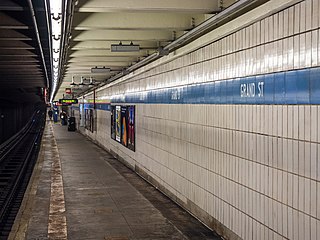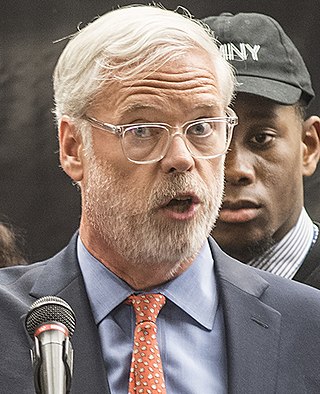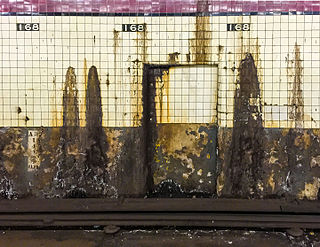
The New York City Subway is a rapid transit system in the New York City boroughs of Manhattan, Brooklyn, Queens, and the Bronx. It is owned by the government of New York City and leased to the New York City Transit Authority, an affiliate agency of the state-run Metropolitan Transportation Authority (MTA). Opened on October 27, 1904, the New York City Subway is one of the world's oldest public transit systems, one of the most-used, and the one with the most stations, with 472 stations in operation.

The Metropolitan Transportation Authority (MTA) is a public benefit corporation responsible for public transportation in the New York City metropolitan area of the U.S. state of New York. The MTA is the largest public transit authority in North America, serving 12 counties in Downstate New York, along with two counties in southwestern Connecticut under contract to the Connecticut Department of Transportation, carrying over 11 million passengers on an average weekday systemwide, and over 850,000 vehicles on its seven toll bridges and two tunnels per weekday.
The Second Avenue Subway is a New York City Subway line that runs under Second Avenue on the East Side of Manhattan. The first phase of this new line, with three new stations on Manhattan's Upper East Side, opened on January 1, 2017. The full Second Avenue Line, if and when it will be funded, will be built in three more phases to eventually connect Harlem–125th Street in Harlem to Hanover Square in Lower Manhattan. The proposed full line would be 8.5 miles (13.7 km) and 16 stations long, serve a projected 560,000 daily riders, and cost more than $17 billion.

The 125th Street station is an express station with four tracks and two island platforms. It is the northernmost Manhattan station on the IRT Lexington Avenue Line of the New York City Subway. Located at Lexington Avenue and East 125th Street in East Harlem, it is served by the 4 and 6 trains at all times, the 5 train at all times except late nights, and the <6> train during weekdays in peak direction. This station was constructed as part of the Dual Contracts by the Interborough Rapid Transit Company and opened in 1918.

The Junius Street station is a station on the IRT New Lots Line of the New York City Subway. Located at the intersection of Junius Street and Livonia Avenue in Brownsville, Brooklyn, it is served by the 3 train at all times except late nights, when the 4 train takes over service. During rush hours, occasional 2, 4 and 5 trains also stop here.

The L 14th Street–Canarsie Local is a rapid transit service in the B Division of the New York City Subway. Its route emblem, or "bullet", is colored medium gray since it serves the BMT Canarsie Line.
The BMT Canarsie Line is a rapid transit line of the B Division of the New York City Subway system, named after its terminus in the Canarsie neighborhood of Brooklyn. It is served by the L train at all times, which is shown in medium gray on the New York City Subway map and on station signs.

The Grand Central–42nd Street station is a major station complex of the New York City Subway. Located in Midtown Manhattan at 42nd Street between Madison and Lexington Avenues, it serves trains on the IRT Lexington Avenue Line, the IRT Flushing Line and the 42nd Street Shuttle. The complex is served by the 4, 6, and 7 trains at all times; the 5 and 42nd Street Shuttle (S) trains at all times except late nights; the <6> train during weekdays in the peak direction; and the <7> train during rush hours and early evenings in the peak direction.

Most trains on the New York City Subway are manually operated. As of 2022, the system currently uses Automatic Block Signaling, with fixed wayside signals and automatic train stops. Many portions of the signaling system were installed between the 1930s and 1960s. Because of the age of the subway system, many replacement parts are unavailable from signaling suppliers and must be custom-built for the New York City Transit Authority, which operates the subway. Additionally, some subway lines have reached their train capacity limits and cannot operate extra trains in the current system.
East Side Access (ESA) is a public works project in New York City that extended the Long Island Rail Road (LIRR) two miles from its Main Line in Queens to the new Grand Central Madison station under Grand Central Terminal on Manhattan's East Side. The Metropolitan Transportation Authority (MTA) project was originally scheduled to open in 2009 but was delayed by more than a decade. The new station and tunnels opened with limited service to Jamaica station in Queens on January 25, 2023, and full service began on February 27, 2023. The estimated cost of the project rose nearly threefold from US$3.5 billion to US$11.1 billion as of April 2018, making it one of the world's most expensive underground rail-construction projects.

Fulton Center is a subway and retail complex centered at the intersection of Fulton Street and Broadway in Lower Manhattan, New York City. The complex was built as part of a $1.4 billion project by the Metropolitan Transportation Authority (MTA), a public agency of the state of New York, to rehabilitate the New York City Subway's Fulton Street station. The work involved constructing new underground passageways and access points into the complex, renovating the constituent stations, and erecting a large station building that doubles as a part of the Westfield World Trade Center mall.

The Grand Street station is an express station on the IND Sixth Avenue Line of the New York City Subway. Located at the intersection of Grand Street and Chrystie Street at the border of Chinatown and the Lower East Side, it is served by the D train at all times and the B train on weekdays.

The Clinton–Washington Avenues station is a local station on the IND Fulton Street Line of the New York City Subway. Located on Fulton Street between Clinton Avenue and Washington Avenue, it is served by the C train at all times except nights, when the A train takes over service.

The 34th Street–Hudson Yards station is a New York City Subway station in Manhattan's West Side on the IRT Flushing Line, and is the western terminus for the 7 local and <7> express services. It has two tracks and one island platform, with two levels of mezzanines: one directly above the platform and the other directly below street level. The station directly serves the Hudson Yards mega-development above it, and is located within the greater Hudson Yards neighborhood. The station contains two entrances along Hudson Boulevard: a primary entrance south of 34th Street, and a secondary entrance south of 35th Street.

Patrick Joseph Foye is an American lawyer who served as Chairman and CEO of the New York Metropolitan Transportation Authority (MTA). Prior to this role, he served as President of the MTA and Executive Director of the Port Authority of New York and New Jersey.

The Second Avenue Subway, a New York City Subway line that runs under Second Avenue on the East Side of Manhattan, has been proposed since 1920. The first phase of the line, consisting of three stations on the Upper East Side, started construction in 2007 and opened in 2017, ninety-seven years after the route was first proposed. Up until the 1960s, many distinct plans for the Second Avenue subway line were never carried out, though small segments were built in the 1970s. The complex reasons for these delays are why the line is sometimes called "the line that time forgot".

The Chambers Street–World Trade Center/Park Place/Cortlandt Street station is a New York City Subway station complex on the IND Eighth Avenue Line, IRT Broadway–Seventh Avenue Line, and BMT Broadway Line. Located on Church Street between Chambers and Cortlandt Streets in Lower Manhattan, it is served by the 2, A and E trains at all times; W train on weekdays; 3, C and R trains at all times except late nights; and N train during late nights.

In 2017, New York Governor Andrew Cuomo declared a state of emergency for the Metropolitan Transportation Authority (MTA) due to ongoing reliability and crowding problems with mass transit in New York City. This order applied particularly to the New York City Subway, which was the most severely affected by dilapidated infrastructure, causing overcrowding and delays. With many parts of the system approaching or exceeding 100 years of age, general deterioration could be seen in many subway stations. By 2017, only 65% of weekday trains reached their destinations on time, the lowest rate since a transit crisis in the 1970s. To a lesser extent, New York City buses operated by the MTA were also affected. Both the subway and the buses are run by the New York City Transit Authority (NYCTA), a subsidiary of the MTA. A separate crisis at Penn Station affected the routes of the three railroad agencies that provided service into the station. Media outlets deemed these crises "the summer of hell".


John Nathan "Janno" Lieber is the head of the Metropolitan Transportation Authority (MTA) in New York. He was appointed acting chair and CEO in July 2021 and confirmed permanently in January 2022.

















